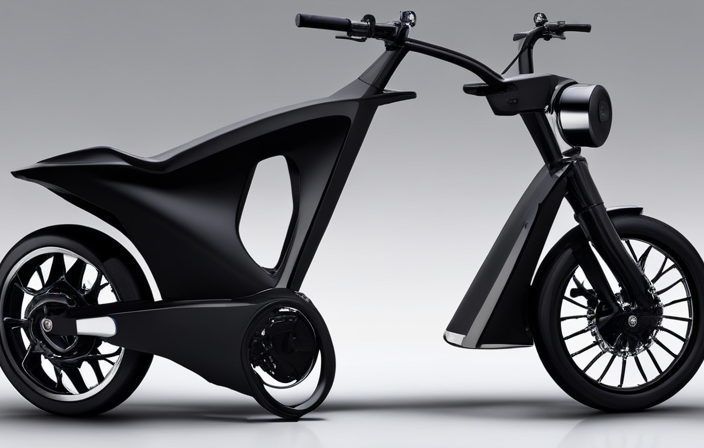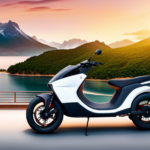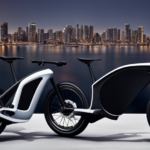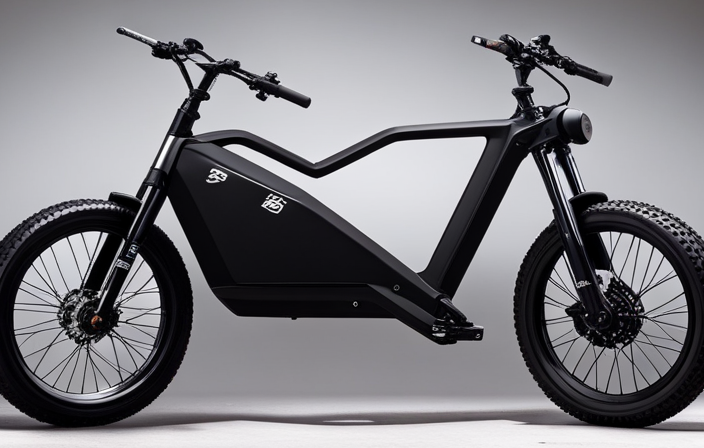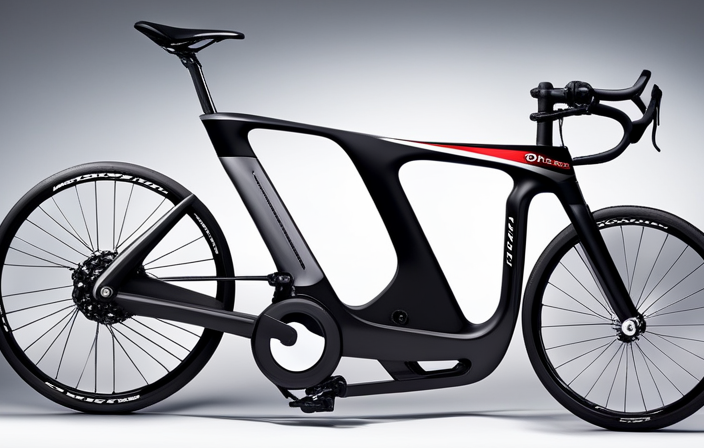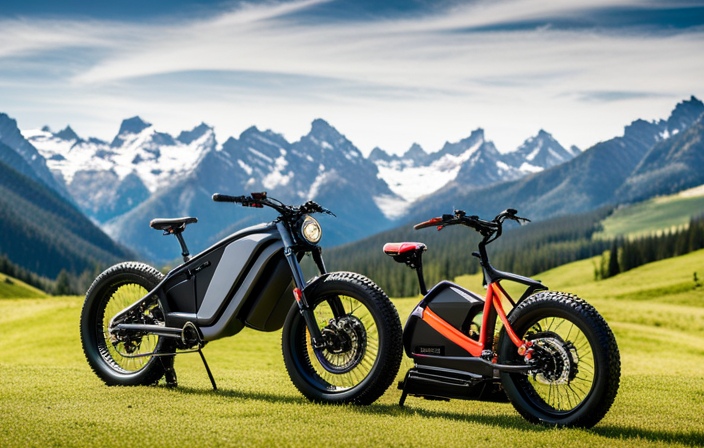As the saying goes, ‘The journey of a thousand miles begins with a single step.’ And for those seeking a sustainable and efficient means of transportation, that step could lead them to the world of electric bikes.
But just how far can these two-wheeled wonders take us? In this article, we will explore the fascinating world of electric bikes and delve into the factors that determine their range.
From battery technology to regulations and safety tips, join me on this informative ride as we uncover the answer to the question: how many miles can an electric bike go?
Key Takeaways
- Electric bikes can go up to 100 miles on a single charge.
- Factors such as terrain, rider weight, and riding style can affect the range of an electric bike.
- Battery capacity and efficiency play a significant role in determining the range of an electric bike.
- Maximizing range can be achieved by riding on flat terrain, maintaining a consistent speed, adopting energy-efficient riding techniques, and regularly maintaining the e-bike.
The Basics of Electric Bikes
Electric bikes, also known as e-bikes, have become increasingly popular due to their ability to assist riders with pedaling and traveling longer distances. One key aspect that enables e-bikes to go the extra mile is their battery technology.
These bikes are equipped with rechargeable lithium-ion batteries that provide power to an electric motor, helping riders conquer hills and ride with ease. The battery capacity determines how far an e-bike can go on a single charge, with some models capable of reaching up to 100 miles.
Additionally, e-bikes offer numerous health benefits. While the motor assists with pedaling, riders still engage their muscles and get exercise, promoting cardiovascular health and strengthening leg muscles.
Now, let’s delve into how electric bikes work and the mechanics behind this innovative mode of transportation.
How Electric Bikes Work
To understand how electric bikes operate, it’s crucial to grasp their underlying mechanics. Electric bikes are powered by electric bike motors and are equipped with electric bike batteries. The motor is responsible for propelling the bike forward, and it is usually located near the pedals or in the rear wheel hub.
The electric bike batteries provide the necessary power to the motor, and they are typically lithium-ion batteries that can be charged using a standard electrical outlet. When you pedal, the motor kicks in and provides an extra boost, making it easier to ride uphill or against strong headwinds. The amount of power provided by the motor can be adjusted using a control panel on the handlebars.
Understanding how electric bike motors and batteries work is essential in determining the factors that affect electric bike range.
[Transition: Now let’s explore the factors that can impact the range of an electric bike.]Factors Affecting Electric Bike Range
When it comes to determining the range of an electric bike, there are several factors that come into play.
First and foremost is the battery capacity, which directly affects how far you can go on a single charge.
Secondly, the terrain and elevation of your ride can greatly impact the range, as riding uphill or on rough terrain will require more power.
Additionally, your weight and riding style play a role, as a heavier rider or aggressive riding can decrease the range.
Lastly, the assistance level of the electric bike also affects the range, as higher levels of assistance will use more power.
Battery Capacity
The battery capacity determines how far an electric bike can go. It is a crucial factor in determining the range of an electric bike. A higher battery capacity allows for a longer range, as it can hold more energy. This means that you can go further on a single charge.
Battery life refers to the amount of time the battery can power the bike before it needs to be recharged. Charging efficiency, on the other hand, refers to how quickly and effectively the battery can be charged.
However, it is important to note that other factors, such as terrain and elevation, also play a role in determining the range of an electric bike. These factors will be discussed in the next section.
Terrain and Elevation
Riding an e-bike on different types of terrain and varying elevations can significantly impact its performance.
When it comes to hill climbing, the power and torque of the electric motor play a crucial role. Steeper inclines require more power, which can drain the battery faster. Additionally, if you encounter a lot of hills during your ride, it’s essential to consider the battery life and make sure it can handle the distance.
Terrain and elevation affect the overall range of an electric bike, as the motor has to work harder to overcome resistance. As a result, you may not be able to cover as many miles on hilly routes compared to flat ones.
Now, let’s explore how rider weight and riding style can also influence the electric bike’s performance.
Rider Weight and Riding Style
A heavier rider or a more aggressive riding style can impact an e-bike’s performance. The heavier you are, the more strain you will put on the e-bike’s motor and battery, which can decrease the overall range. A more aggressive riding style, characterized by frequent acceleration and high speeds, can also drain the battery more quickly.
To optimize the range of your electric bike, consider the following:
- Opt for a higher capacity battery to accommodate your weight and riding style.
- Choose a bike with a powerful motor that can handle the extra load.
- Use pedal-assist mode instead of relying solely on the throttle to conserve battery power.
- Maintain a consistent and steady pace to maximize efficiency.
Considering rider weight impact and riding style effects, it’s important to also factor in the assistance level provided by the e-bike, which we will discuss in the next section.
Assistance Level
When it comes to electric bikes, the assistance level you choose can greatly affect how many miles you can go on a single charge. The assistance level determines how much power the motor provides, and the higher the level, the more assistance you get. This means that if you choose a higher assistance level, you’ll be able to cover more miles before the battery runs out. However, it’s important to keep in mind that using a higher assistance level will also drain the battery faster, so you’ll need to find a balance between power and battery life. Understanding the different assistance levels and how they affect battery life is key to maximizing the range of your electric bike. Speaking of battery life, the next section will delve into understanding battery types and technology.
Understanding Battery Types and Technology
To understand battery types and technology, you’ll need to know how they impact the range of an electric bike.
The battery life of an electric bike is determined by its capacity and the efficiency of the motor. Higher capacity batteries can store more energy and provide longer rides. Additionally, advancements in charging technology have made it easier and faster to recharge electric bike batteries. Some electric bikes even have removable batteries, allowing you to charge them indoors.
It’s important to consider these factors when choosing an electric bike, as they directly affect how far you can ride on a single charge. Now, let’s explore some electric bike range examples and see how different factors can influence the distance you can travel.
Electric Bike Range Examples
You can gauge the range of an electric bike by considering various factors such as battery capacity, motor efficiency, and advancements in charging technology. When comparing electric bike ranges, it is important to note that different models have different capabilities. For example, a basic electric bike may have a range of around 20-30 miles, while a higher-end model with a larger battery can reach up to 60-80 miles on a single charge.
Factors affecting battery life include terrain, rider weight, and speed. Riding on hilly terrain or carrying extra weight can significantly reduce the range, while riding at a consistent speed and on flat terrain can help maximize the distance you can travel.
In the next section, I will provide tips for maximizing electric bike range without compromising on performance.
Tips for Maximizing Electric Bike Range
One way to extend your electric bike’s range is by optimizing your riding style and habits. By adopting energy efficient riding techniques, you can maximize your battery life and go the extra mile. Here are some tips for maximizing electric bike range:
| Riding Technique | Energy Saving Effect |
|---|---|
| Maintain a steady pace | + |
| Avoid rapid acceleration and braking | + |
| Pedal lightly while using the motor | + |
| Utilize regenerative braking | + |
| Choose the right assistance level | + |
By following these tips, you can make your electric bike more energy efficient and increase its range. In the next section, we will explore the various charging options and times for electric bikes, ensuring that you have all the information you need to keep your bike powered up and ready to ride.
Charging Options and Times
When it comes to charging options and times for electric bikes, there are three key points to consider.
First, home charging is the most convenient option. You can simply plug your bike into a regular outlet and let it charge overnight.
Second, portable chargers are great for on-the-go charging. They allow you to top up your bike’s battery wherever you are.
Lastly, charging stations are becoming more common in cities. They offer a quick and efficient way to charge your electric bike while you’re out and about.
These three options provide flexibility and convenience for electric bike owners.
Home Charging
To maximize the range of your electric bike, it’s important to have a convenient home charging setup. Having a reliable home charging station ensures that your electric bike is always ready for the road. Here are three key aspects to consider for your home charging infrastructure:
-
Charging station installation: Install a dedicated charging station at your home to make charging your electric bike hassle-free. This ensures a consistent power supply and speeds up the charging process.
-
Charging connector options: Choose a charging connector that is compatible with your electric bike’s battery. Common options include Type 1, Type 2, and CHAdeMO connectors.
-
Charging speed: Opt for a charging station that provides fast charging capabilities. This reduces the time it takes to charge your electric bike and maximizes its range.
With a reliable home charging setup, you can conveniently charge your electric bike and extend its range.
Moving on to portable chargers, these offer flexibility when you’re on the go.
Portable Chargers
If you’re looking for flexibility and convenience, portable chargers are a great option for keeping your electric bike charged while you’re on the move.
Portable chargers are designed to be compatible with various electric bike models, ensuring that you can charge your bike wherever you are.
They are lightweight and compact, making them easy to carry in your backpack or bike bag.
When using a portable charger, it is important to optimize the charging time to ensure maximum efficiency.
This can be done by using a charger with a higher amperage output or by charging your bike battery when it is at a lower state of charge.
By utilizing these techniques, you can minimize the time it takes to charge your electric bike and maximize your riding time.
Looking ahead, let’s explore the benefits of using charging stations for your electric bike.
Charging Stations
Charging stations offer a convenient and reliable way to recharge your e-bike. These stations provide a variety of charging options, including wireless charging and fast charging. Wireless charging allows you to simply place your e-bike on a charging pad, eliminating the need for any cables or connectors. This technology is not only convenient but also ensures a more efficient charging process. Fast charging, on the other hand, allows you to quickly top up your e-bike’s battery in a short amount of time, perfect for those who are always on the go. With the increasing popularity of electric bikes, the availability of charging stations is also growing, making it easier than ever to keep your e-bike fully charged. Looking ahead to the future of electric bike range, advancements in battery technology and charging infrastructure will continue to push the boundaries of how far these bikes can go.
The Future of Electric Bike Range
In discussing the future of electric bike range, it is important to consider the advancements in battery technology. As batteries continue to improve, we can expect electric bikes to have longer ranges and more power.
Additionally, the development of extended range models will allow riders to travel even greater distances on a single charge. These advancements in battery technology and the introduction of extended range models are exciting prospects for the future of electric bike range.
Advances in Battery Technology
You can increase the mileage range of an electric bike by taking advantage of advances in battery technology.
In recent years, there have been significant advancements in battery technology that have greatly improved the performance and range of electric bikes.
These advancements include the development of high-capacity lithium-ion batteries, which can store more energy and provide longer rides.
Additionally, the use of advanced battery management systems has improved the efficiency and lifespan of batteries, allowing for more consistent performance over time.
These advancements not only benefit electric bike riders by allowing them to travel longer distances, but they also have a positive impact on the environment by reducing the need for fossil fuel-powered transportation.
As a result, electric bikes with extended range models have become more popular among cyclists who want to go the extra mile without compromising on sustainability.
Extended Range Models
To maximize your travel distance, consider opting for an electric bike with an extended range model. These models are specifically designed to offer longer battery life and increased mileage, allowing you to go further on a single charge. Thanks to advancements in battery technology, extended range models have become increasingly popular among electric bike enthusiasts.
They offer a range of benefits, including:
- Larger battery capacities: Extended range models often come equipped with larger battery capacities, allowing for more energy storage and longer rides.
- Efficient power management: These bikes utilize advanced power management systems that optimize the use of battery power, ensuring a longer-lasting charge.
- Improved charging times: With faster charging capabilities, extended range models can be conveniently charged in a shorter amount of time.
By choosing an electric bike with an extended range model, you can enjoy extended rides without worrying about running out of battery power.
Transitioning into the next section, electric bikes also play a significant role in promoting sustainability.
Electric Bikes and Sustainability
Electric bikes can go for many miles on a single charge, making them a sustainable mode of transportation. These bikes have a minimal environmental impact as they produce zero emissions while in use. With the increasing concerns about air pollution and climate change, electric bikes provide an eco-friendly alternative to traditional vehicles.
Additionally, electric bikes contribute to improving urban mobility by reducing traffic congestion and offering a faster and more flexible mode of transportation in crowded cities. They can easily maneuver through traffic and reach destinations quickly, making them a convenient choice for daily commuting.
Moreover, electric bikes promote a healthier lifestyle by encouraging physical activity. Riding an electric bike provides a low-impact workout and can help improve cardiovascular health and overall fitness.
Transitioning into the next section, electric bikes not only benefit the environment and urban mobility but also offer numerous health advantages.
Electric Bikes and Health Benefits
When it comes to electric bikes and health benefits, there are two key points to consider: increased physical activity and improved cardiovascular health.
Riding an electric bike can provide a great way to get more exercise, as it requires pedaling and controlling the bike. This increased physical activity can help burn calories and improve overall fitness.
Additionally, the cardiovascular benefits of riding an electric bike include improved heart health, increased stamina, and better blood circulation.
So, not only can electric bikes be a fun and convenient mode of transportation, but they can also have positive effects on our physical well-being.
Increased Physical Activity
You can significantly increase your physical activity by riding an electric bike. Electric bikes are a great option for those who may have physical limitations or are looking to gradually increase their fitness level.
With an electric bike, you can choose the level of assistance you need, allowing you to pedal as much or as little as you want. This means that even if you’re not a seasoned cyclist, you can still enjoy the benefits of increased physical activity.
Riding an electric bike can help improve your cardiovascular health, strengthen your muscles, and burn calories. It’s a fun and efficient way to incorporate more movement into your daily routine.
Plus, the added assistance from the electric motor can help you tackle inclines and longer distances with ease. So hop on an electric bike and start reaping the health benefits today!
Improved Cardiovascular Health
Increased physical activity is just one of the many benefits of riding an electric bike. By incorporating this mode of transportation into my daily routine, I have noticed a significant improvement in my cardiovascular health.
The regular exercise provided by riding an electric bike has led to improved cardiovascular fitness, as it gets my heart pumping and increases blood circulation throughout my body. This increased activity has also helped reduce my sedentary lifestyle, which is known to have negative effects on cardiovascular health.
By choosing to ride an electric bike instead of relying solely on motorized transportation, I am actively taking steps towards improving my overall well-being.
Moving forward, let’s explore another advantage of electric bikes: their cost savings.
Electric Bikes and Cost Savings
Electric bikes can save you money on transportation costs. Not only are they more affordable to purchase compared to cars or motorcycles, but they also have lower operating costs. A cost analysis shows that the average cost to charge an electric bike is around $0.10 per mile, while the cost to fuel a car is around $0.15 per mile. Over time, these savings can really add up, especially for those who rely on their bikes for daily commuting.
Additionally, electric bikes have a lower environmental impact compared to traditional vehicles, as they produce zero emissions and require less energy to operate. By choosing an electric bike as your mode of transportation, you can save money and contribute to a greener environment.
Now, let’s delve into the regulations and laws surrounding electric bikes.
Electric Bike Regulations and Laws
When it comes to electric bike regulations and laws, there are a few key points to consider.
First, it is important to familiarize oneself with the local traffic laws, as these can vary from place to place.
Additionally, understanding the difference between pedal-assist and throttle-controlled electric bikes is crucial, as each type may have different regulations and restrictions.
Overall, staying informed and adhering to the relevant laws is essential for a safe and legal electric bike experience.
Local Traffic Laws
Remember to familiarize yourself with the local traffic laws before hopping on your electric bike. It is crucial to prioritize pedestrian safety and adhere to bike lane regulations when riding. In some areas, electric bikes are allowed on bike lanes, while in others, they must be ridden on the road. It is important to know the specific regulations in your area to ensure you are following the law.
Additionally, understanding how to safely navigate through intersections and yield to pedestrians is essential. Being aware of traffic signals and signs, such as stop signs and yield signs, is also crucial for your safety and the safety of others. Learning about the local traffic laws will help you ride confidently and responsibly.
Now, let’s delve into the exciting discussion about pedal-assist vs. throttle-controlled electric bikes.
Pedal-Assist vs. Throttle-Controlled
To understand the difference between pedal-assist and throttle-controlled electric bikes, it’s important to consider how each type of bike operates.
-
Pedal assist vs. throttle controlled: Pedal-assist bikes use sensors that detect when the rider is pedaling and provide an extra boost of power to assist with pedaling. Throttle-controlled bikes, on the other hand, have a throttle mechanism that allows the rider to control the speed without pedaling.
-
Battery technology advancements: With advancements in battery technology, electric bikes now have longer ranges and faster charging times. This means you can ride farther on a single charge and spend less time waiting for your battery to recharge.
-
Electric bike safety regulations: As electric bikes gain popularity, safety regulations are being put in place to ensure the safety of riders and other road users. These regulations include speed limits, helmet requirements, and rules for riding on bike lanes or roads.
-
Electric bike popularity trends: Electric bikes are becoming increasingly popular as a mode of transportation and recreation. More and more people are realizing the benefits of electric bikes, such as reduced carbon emissions, improved fitness, and the ability to easily navigate through traffic.
-
Transition: Understanding the differences between pedal-assist and throttle-controlled electric bikes, as well as the advancements in battery technology and safety regulations, is crucial for enjoying the ride.
Now, let’s explore some electric bike safety tips to ensure a safe and enjoyable experience.
Electric Bike Safety Tips
One important aspect of electric bike safety is being aware of your surroundings. It is crucial to always pay attention to the road, pedestrians, and other vehicles while riding an electric bike. In addition to being aware, there are a few key safety tips to keep in mind.
First, make sure to wear a helmet to protect your head in case of an accident. Second, follow traffic laws and signals, just like you would on a regular bicycle. Third, regularly maintain your electric bike to ensure it is in good working condition. This includes checking the brakes, tires, and lights. Lastly, choosing the right electric bike for your needs is essential. Consider factors such as the battery range, motor power, and frame design.
By following these safety tips and selecting the right electric bike, you can enjoy a safe and enjoyable ride. Now, let’s dive into popular electric bike models and brands.
Popular Electric Bike Models and Brands
Now that we’ve covered some important safety tips for riding electric bikes, let’s dive into the world of popular electric bike models and brands.
When it comes to choosing an electric bike, there are plenty of options available in the market. Some well-known brands include Rad Power Bikes, Trek, and Specialized. These brands offer a range of models with different features and specifications to cater to various riding needs.
Prices for electric bikes can vary depending on the brand and model, ranging from around $1,000 to $5,000 or even more for high-end models. It’s always a good idea to read customer reviews before making a purchase, as they can provide valuable insights into the performance, durability, and overall satisfaction of the bike.
So, let’s explore the world of electric bikes and see what customers have to say about these popular models.
Now, let’s move on to the conclusion: embrace the electric bike revolution.
Conclusion: Embrace the Electric Bike Revolution
So why not hop on board and join the electric bike revolution? Electric bike adoption is on the rise, and for good reason. Not only do electric bikes provide a fun and efficient mode of transportation, but they also have a positive environmental impact. By choosing to ride an electric bike instead of a car, you can significantly reduce your carbon footprint and contribute to cleaner air and a healthier planet. Electric bikes are powered by rechargeable batteries and have an impressive range, allowing you to travel long distances without worrying about running out of power. To give you an idea of the range of popular electric bike models, here is a comparison table:
| Model | Range (miles) |
|---|---|
| Model A | 40 |
| Model B | 50 |
| Model C | 60 |
With advancements in battery technology, electric bikes are becoming even more efficient, allowing you to go further than ever before. So why not embrace the electric bike revolution and make a positive impact on the environment while enjoying the many benefits of electric bike commuting?
Frequently Asked Questions
Are electric bikes more expensive than traditional bikes?
Yes, electric bikes are generally more expensive than traditional bikes. However, the benefits of an electric bike, such as increased speed and ease of pedaling, justify the higher price. When comparing electric bike prices, it’s important to consider the quality and features offered.
Can I use an electric bike in the rain?
Yes, you can ride an electric bike in the rain. However, it’s important to take precautions such as using fenders, wearing waterproof clothing, and avoiding deep puddles. When storing an electric bike in the winter, keep it in a dry and protected area to prevent any damage.
What are the maintenance requirements for an electric bike?
To properly maintain an electric bike, it’s important to follow a maintenance schedule. This includes regular cleaning, checking tire pressure, lubricating the chain, and inspecting the brakes. Common repairs may include replacing worn-out tires or brake pads.
How long does it take to charge an electric bike battery?
Charging an electric bike battery can take anywhere from 3 to 8 hours, depending on the model and charger. It’s important to note that frequent fast charging can reduce the battery lifespan, so it’s best to follow the manufacturer’s recommended charging guidelines.
Can I ride an electric bike on public roads?
Yes, I can ride an electric bike on public roads. However, it’s important to be aware of electric bike safety and follow the rules and regulations for electric bike riders to ensure a safe and legal riding experience.
Conclusion
In conclusion, the electric bike revolution is here to stay. With advancements in battery technology and increased range capabilities, electric bikes are becoming a viable mode of transportation for many.
Whether you’re looking to commute to work, explore new trails, or simply enjoy a leisurely ride, electric bikes offer a versatile and eco-friendly option.
So, why limit yourself to traditional bikes when you can experience the thrill of an electric bike? Isn’t it time you joined the movement and embraced the freedom and convenience they offer?

